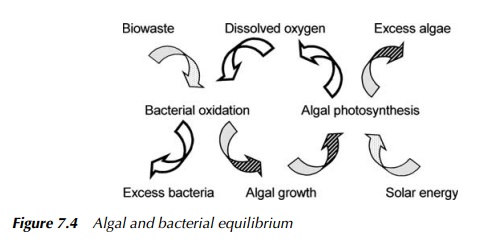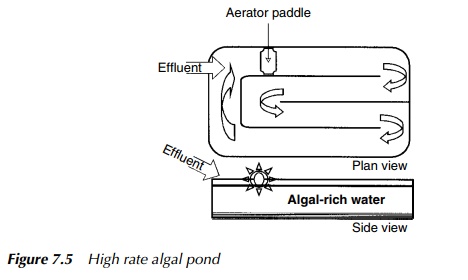Chapter: Environmental Biotechnology: Phytotechnology and Photosynthesis
Effluent treatment
Effluent treatment
Algal effluent treatment systems work on the basis of functional
eutrophication and rely on a dynamic equilibrium between the autotrophic algae
themselves and the resident heterotophic bacteria, which establishes a
two-stage biodegradation/assimilation process, as shown in Figure 7.4. In
effect this is an ecological microcosm in which organic contaminants present in
the wastewater are biolog-ically decomposed by the aerobic bacteria, which make
use of oxygen provided by algal photosynthesis, while the algae grow using the
nutrients produced by this bacterial breakdown, and photosynthesise producing
more oxygen.

Though the process is
self-sustaining, it is also self-limiting and left to pro-ceed unchecked, will
result in the well-appreciated characteristic eutrophic stages leading to the
eventual death of all component organisms, since true climactic balance is
never achieved in the presence of continuously high additional nutri-ent
inputs. The removal of excess algal and bacterial biomass is, therefore, an
essential feature, vital to maintaining the system’s efficiency.
Of all the engineered algal
systems for effluent, the high rate algal pond (HRAP) is one of the most
efficient and represents a good illustration of this use of phytotechnology.
Figure 7.5 shows a typical example.

The system consists of a
bioreactor cell in the form of a relatively shallow reservoir, typically
between 0.2 – 0.6 metres deep, with a length to width ratio of 2:1 or more, the
idea being to produce a large surface area to volume ratio. The void is divided
with internal baffles forming walls, to create a channel through which the
effluent flows. A mechanically driven paddle at the end nearest to the effluent
input both aerates and drives the wastewater around the system.
These ponds are not sensitive to fluctuations in daily feed, either
in terms of quantity or quality of effluent, providing that it is fundamentally
of a kind suitable for this type of treatment. Consequently, they may be fed on
a continuous or intermittent basis. The main influences which affect the
system’s performance are the composition of the effluent, the efficiency of
mixing, the retention time, the availability and intensity of light, pond depth
and temperature. The latter two factors are particularly interesting since they
form logical constraints on the two groups of organisms responsible for the
system’s function, by affecting the autotrophe’s ability to photosynthesise and
the heterotrophe’s to respire. While a deeper cell permits greater resident
biomass, thus elevating the numbers of micro-organisms available to work on the
effluent, beyond a certain limit, the law of diminishing returns applies in
respect of light available to algae in the lower reaches. Warmer temperatures
increase metabolic activity, at least within reason,and the rate of
straightforward chemical reactions doubles per 10 ◦C rise, but at the same
time, elevated water temperatures have a reduced oxygen-carrying capacity which
affects the bacterial side of the equilibrium mentioned earlier. As with so
much of environmental biotechnology, a delicate balancing act is required.
After a suitable retention
period, which again depends on the character of the effluent, the design and
efficacy of the treatment pond and the level of clean-up required, the water is
discharged for use or returned to watercourses. Obviously, after a number of
cycles, algal and bacterial growth in a functionally eutrophic environment
would, as discussed earlier in the section, begin to inhibit, and then
eventually arrest, the biotreatment process. By harvesting the algal biomass,
not only are the contaminants, which to this point have been merely
biologically iso-lated, physically removed from the system, but also a local
population depression is created, triggering renewed growth and thus optimised
pollutant uptake. The biomass recovered in this way has a variety of possible
uses, of which compost-ing for ultimate nutrient reclamation is without doubt
the most popular, though various attempts have also been made to turn the algal
crop into a number of different products, including animal feed and insulating
material.
Related Topics